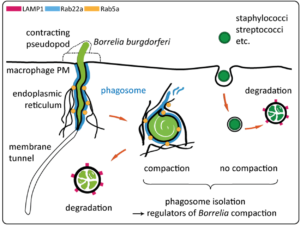P4 – Proteome-based analysis of Borrelia phagosome compaction
Principal Investigator
Prof. Dr. rer. nat. Stefan Linder
University Medical Center Hamburg-Eppendorf
Institute of Medical Microbiology, Virology and Hygiene

Project Summary

Borrelia burgdorferi is the causative agent of Lyme disease, a multisystemic disorder affecting skin, nervous system and joints. Uptake and intracellular processing of borreliae by host cells proceed in several steps: i) immobilisation of highly motile borreliae by formin-regulated filopodia1,3, ii) enwrapment by a coiling pseudopod, regulated by the formin Daam1 and Arp2/3 complex1,2, iii) uptake into a Rab22a-positive phagosome, which is contacted by Rab5a-positive vesicles in an ER-dependent manner2, iv) compaction of borreliae by reduction of the phagosome surface through membrane tubulation2,4, v) degradation in mature phago-lysosomes2,4 (see also Fig.). We also identified lipids such as PI(3)P and phosphatidylserine that play specific roles during uptake and processing of borreliae4,5. Moreover, we recently discovered that membrane tunnels, a novel phagocytic structure, extend deeper into the host cell cytoplasm than the bacteria-containing part of phagosomes, probably due to partial extrication of highly motile borreliae (see Fig.). This shows that internalisation of borreliae by macrophages is a unique and highly dynamic process, whose outcome depends on a tug-of-war between spirochetes and host cells5. Notably, both phagosomes and tunnels form multiple STIM1-positive ER contact sites, pointing to a role of ER-connected processes, including regulation of Ca2+ influx, in the maturation of borreliae containing phagosomes5. However, the roles of ER contact sites and specifically phagosomal Ca2+ influx in borreliae phagosome maturation are currently unclear. To address these questions, and to identify Borrelia-specific regulators of phagosome compaction and maturation, we have established magnetic labelling of borreliae, permitting subsequent purification of phagosomes. Results from these experiments will identify novel targets for modulation of intracellular processing of spirochetes in human immune cells.
This project will a) analyse the proteome and lipidome of Borrelia-containing phagosomes and tunnels, b) characterise ER contact sites at phagosomes and tunnels on a molecular and functional level, and c) identify regulators that are specific for compaction of spirochetes, as opposed to bacteria without pronounced phagosomal compaction such as staphylococci and streptococci, or which follow different strategies for intracellular survival or persistence such as Yersinia, Legionella or Salmonella. SILAC labelling of macrophages will be combined with chemical crosslinking, (co-) immunoprecipitation and proximity labelling assays to identify ligands on the Borrelia surface involved in recruiting the molecular machinery driving phagosome/tunnel closure and phagosome compaction. Lattice light sheet microscopy and focused ion beam microscopy will be used to analyse membrane flow at phagosomes and tunnels.
References
1. Hoffmann AK, Naj X, Linder S (2014) Daam1 regulates filopodia formation and phagocytosis of Borrelia burgdorferi by primary human macrophages. FASEB J 28:3075-89. Abstract
2. Naj X, Linder S (2015) ER-coordinated activities of Rab22a and Rab5a drive endosomal compaction and intracellular processing of Borrelia burgdorferi by macrophages. Cell Rep 12:1816-30. Abstract
aj X, Linder S (2017) Actin regulation during phagocytosis of Borrelia burgdorferi by macrophages. Curr Topics Microbiol Immunol 399:133-54. Abstract
4. Klose M, Linder S (2019) Sorting nexin-3 drives maturation of Borrelia-containing phagosomes by forming a hub for PI(3)P, Rab5a and galectin-9. J Cell Biol 218:3039-59. Abstract
lose M, Linder S (2021) FIB-SEM-based analysis of Borrelia intracellular processing by human macrophages. J Cell Sci 134:jcs252320. Abstract
